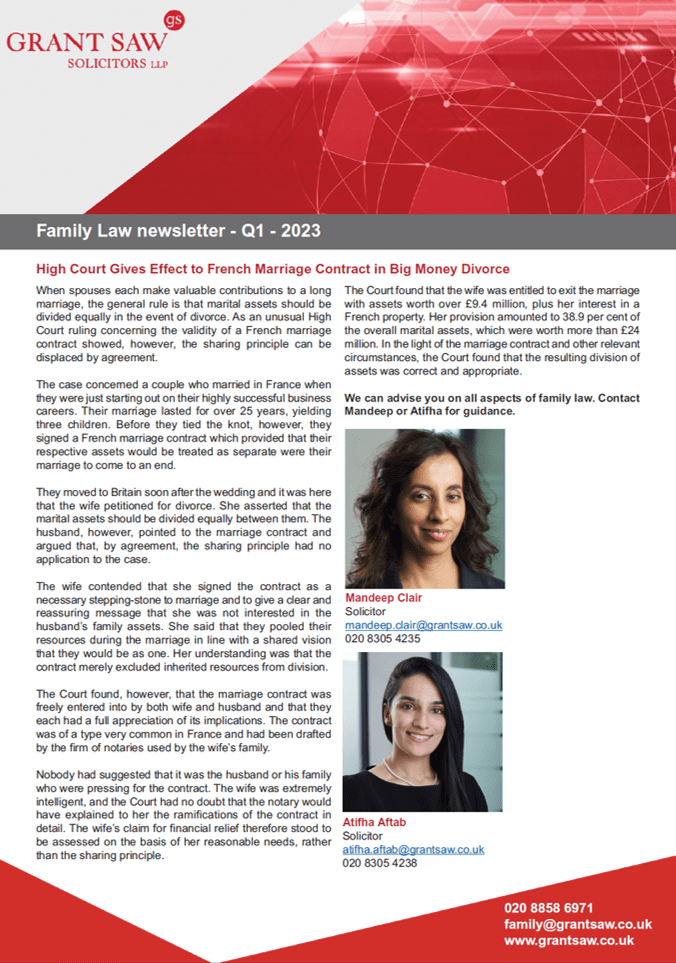Obtaining a Grant of Representation will provide an Executor or Administrator control over the deceased’s estate and is therefore an important stage in the administration of most estates. A Grant of Representation would ordinarily be required if an estate exceeds £5,000 (after funeral expenses have been paid). A legal document known as a ‘Caveat’ can however be lodged at a Probate Registry which will prevent a Grant of Representation from being made whilst the Caveat remains in force.
There are two main types of Grants of Representation. Either a Grant of Probate, which would apply if the Deceased made a Will, or a Grant of Letters of Administration where the deceased died intestate (without having made a Will). In the interest of brevity, we refer below, solely to a Grant of Probate. The same issues discussed will also however apply to a Caveat which prevents a Grant of Letters of Administration from being obtained.
Why would someone need this service?
In some situations it may be important to seek to prevent a Grant of Probate from being obtained. The procedure for taking such action is to lodge a document known as a Caveat. Common situations where it may be advisable to do this are as follows:
- If there is concern that the Will was not properly signed or witnessed.
- There is concern that the deceased did not have the mental capacity to make a Will.
- There is a suggestion the Will is fraudulent.
- There is a suggestion that an undue influence was exerted on the person making the Will, to the extent that the Will did not represent their true wishes.
- There is a concern that the person seeking to obtain the Grant of Probate may not be a suitable person to do so.
If any of the above scenarios apply, then a Caveat may be lodged at any Probate Registry. A copy of the relevant form can be found here : (https://assets.publishing.service.gov.uk/government/uploads/system/uploads/attachment_data/file/845943/pa8a-eng.pdf ). There is currently a £3 fee to pay on lodging a Caveat.
Once obtained a Caveat will last for a period of 6 months, unless it is voluntarily withdrawn. This initial 6 month period can be extended for a further period of 6 months and beyond if required. If the time period is not extended the Caveat will lapse. As long as a Caveat is in place, it will prevent anyone from obtaining a Grant of Probate without formal steps being taken to remove it.
A Caveat can be removed if the person who lodged the Caveat decides to do so voluntarily, or someone objects to the Caveat remaining in place and that objection is upheld. An objection to the issuing of a Caveat is made by lodging a legal document known as a “Warning” at the Probate Registry. If a Warning is issued, then the person who entered the Caveat has two options: either to agree that the Caveat should be withdrawn; or to state why the Caveat should remain in place. If the Caveat is to remain in place, an explanation as to why it has been lodged and should remain in place must be set out in a further legal document known as an “Appearance” at the Probate Registry.
If an Appearance is entered, the Caveat will remain as a permanent fixture and it can then only be removed by either court proceedings being commenced and the court deciding the issue in dispute, or either party issuing a Summons seeking its removal which will be heard before a District Probate Registrar.
Irrespective of whether you are seeking to lodge or remove a Caveat it is very important that you obtain good legal advice at the outset. Unfortunately, maintaining an incorrect position in relation to a Caveat may lead to adverse costs consequences being made against you.
Please note, the procedure described above, is not appropriate when a claim is being sought under the Inheritance (Provision for Family and Dependants) Act 1975 (’The 1975 Act’). In that situation, the parties should allow a Grant of Probate to proceed. There is further discussion regarding claims being made under the 1975 Act here.
How long is the process of obtaining a caveat or seeking the removal of it?
A Caveat can be obtained fairly promptly, usually within 7 to 14 days of issuing an application to the Probate Registry.
With regard to seeking to remove a Caveat; if a “Warning” is served on the person who obtained the Caveat, that person will have a period of 14 days to enter an “Appearance” from the date the warning is served to state why they believe the Caveat should remain in place.
It can sometimes be difficult to find out whether a Caveat has been lodged as there is no requirement that once lodged the Caveat must be served on anyone. Therefore Personal Representatives may first learn of the existence of a Caveat when a Grant of Probate is applied for.
Is it expensive?
The procedure for entering a Caveat itself is unlikely to be expensive. The probate fee for instance is currently only £3.
The filing of a Caveat or its removal is unlikely to be a straightforward issue however. There will be probably be wider considerations in place. For instance, why was a Caveat sought in the first place? It is those issues which will need to be carefully considered and ultimately resolved in order for the estate to be properly administered.
We will provide you with a cost estimate at the outset and in advance. Furthermore the cost estimate will be updated if the matter proceeds.
What should people do before calling?
If there was a Will, it would be useful to have that document to hand. Similarly if a Caveat or a Warning has already been obtained, then it would be useful to have those documents also.
To make a free enquiry, please call now on 020 8858 6971 to arrange a mutually convenient time for a telephone discussion or email us today.
- https://grantsaw.com/People/michael-clary
- https://grantsaw.com/People/kalpa-prajapati
- https://grantsaw.com/People/simona-morina
Meet the Contested trust and probate disputes team















































